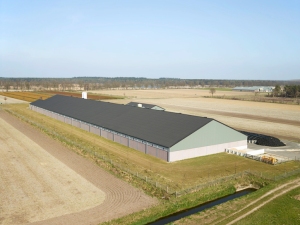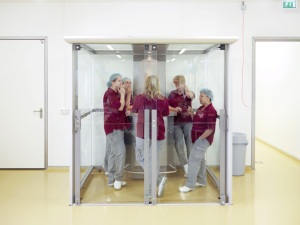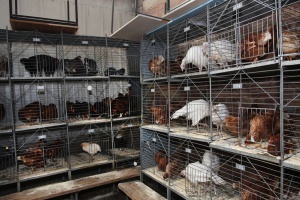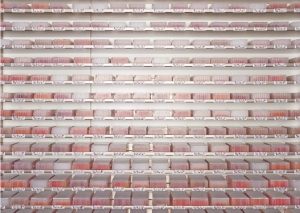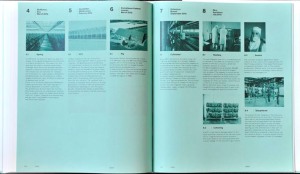Of contemporary agriculture : Flock and Food.
Posted: May 19, 2014 Filed under: Photobooks Leave a commentThe world is moving fast, in a never ending race to more globalization and more profits, thereby, we loose a lot in this absurd spiral. However, I found very funny to compare the two books, reviewed here. They draw our attention to this evolution and its collateral damages on the relationships within our society.
“Flock“ by Ken Grant and “Food“ by Henk Wildschut.
It becomes an oxymoron to draw a parallel between these two books as they are so much opposed. The topic is the same : where does the food we eat come from ? But, well… In one sentence, I have listed everything they have in common. You may say that’s already a lot, and you’re right, this is the reason why I like so much these two books. They are the thesis and antithesis of the same essay.
Ken Grant is an English photographer, already known for his work in his hometown Liverpool. He mainly focuses, in a documentary style, on the social life and the different relationships between human beings in our society. He is more known for his black and white photography, done in an immersion situation within the community of people who becomes his subject. One of his main characteristics is his very close relationship with the persons, which reflects an empathy for the whole population.
In “Flock“, we discover a work in color that he did in Hereford at the livestock market which was planned to be removed from the center, to the outskirts of the town. He came, again and again, during the last few years to the market with the purpose of documenting the change of a world. Change of a world which was part of the daily life, a world where a man knew where the egg in his plate came from, or who was able to tell you what a sheep looked like. When I was a child, I used to visit grand-aunties in Bretagne. At that time, they had a farm and it was an incredible experience to drink the warm milk, fresh from the cow !
This is an old world that Ken Grant shows us. We may be pretty sure that the relocation is the signal of the fall of those open markets. They also had an incredible pedagogic value. This was where children were educated to agriculture. They discovered animals in those many sheds where they could touch them. They saw animal babies and many grown-ups, dirty, without asepsis, but all in a joyfull big mess, which was only understandable by initiated people. The event was an awaited highlight in the yearly life of the town. This was also the moment for the farmers to reap the benefits of a year long activity, which would guarantee the forthcoming year. We read, in the composition of the photographs, the tension between the sellers and the buyers, they are all walking on a tight rope to get the best deal possible. The deal can be done with a wink, or by shaking hands ; the flock has its own vocabulary, and if you look close enough, you may find some of those signs in Ken Grant’s images.
And here is the quality of the book of Ken Grant, he succeeds wonderfully to restitute this ambiance. We are immerged in the middle of the flock, as the title said, we fight to gain access to the first row, we bend and we shout with everybody, we are part of humanity ! Some photos are hilarious, in a struggle for life spirit. We could almost smell musky odors around.
The conclusion could be : is there any places remaining for those unregulated and non optimised markets, in regards of globalization? Which introduces the second book.
Henk Wildschut, a Dutch photographer, was commissionned a couple of years ago to do an in-depth study of the subject of food in Netherlands. He was originally, full of preconceptions about the (un)ethical industrial process, but did not want to orient his work in one single direction. For him it is not a question of good versus bad, and Henk Wildschut does not want to report any dysfunctions in the modern agriculture. There may be some advantages with extensive agriculture, but beyond that, I find interesting with this second book, is to see, how the production process induces a different relation between producers and customers, and also a different perception of what we eat.
What we see in Henk’s photographs are deserted sanitized areas with animals isolated and (too much) cleaned. The corridors are almost empty and the only place where we discover a group of people is the smoking room provided to avoid workers to go out, and loose time in changing clothes. When we see someone, it is a close-up portrait without any context, the model seems to be absent, or maybe boring, looking elsewhere. They show no expressions, they are as unexpressive as their surroundings.
For sanitary reasons, it is impossible, for non workers, to enter those places which look like a modern plant. At the end of the chain, we discover pieces of meat in a plastic box, shrink wrapped. Due to mechanization, they have all the same weight, which reinforced the weirdness.
The ambiance is no less colorful than in Hereford, but the tones have changed. The bricks have turned to concrete, the wood shelves are now metallic cupboards. Like if all colors and materials would have been exchanged for their complementary opposites.
About aesthetics, there is another funny comparison between photographs excerpted from each series which show, side by side, chickens and hens in their respective worlds, and different conditionnings. This could summarize the complete opposition between the two worlds.
The opposition also appears in the organisation of the books. When “Flock” just alternates the photographs in no particular order understandable by the reader, “Food” shows photographs organised and referenced with a sober caption, very descriptive. All photographs come with a number which refers to the shooting location, and a typology name which refers to the process. It already appears from outside, when you see people glued to each others on “Flock” cover, and on the opposite, “Food” cover shows sanitized glass dishes which remind us the laboratory process.
After the comparison of those two worlds, it is not the purpose to conclude in a better or worse way of production, whether in terms of health, polution or meat quality. There is no nostalgy neither magnification of modernism, but this will definitely point out a change, nothing more, but nothing less neither. It is easy to imagine that everybody will have his own idea on the subject, but it is a never ending discussion. Ken Grant and Henk Wildschut brought us their little contribution, which can’t be summarized to “pro” and “against”. The very high aesthetics qualities of the two series emphasize the ambivalence of our relationship to agriculture, whether it is traditionally extensive or contemporary intensive, and beyond… to our relationship to food?
Flock is published by Artist Photo Books, hardcover, 30 x 21 cm, 96 pages, 2014.
Food is published by Post Editions, hardcover, 24 x 28 cm, 144 pages, in two editions, English and Dutch, 2013.
More infos:
http://www.artistphotobooks.ie/
http://www.henkwildschut.com/work/food/food-photo/
http://www.post-editions.com/?page=food
Flock can be bought here : http://ascenseurvegetal.com/en/monographie/456-flock-signed.html
All images copyright Ken Grant, Henk Wildschut, Artist Photo books, Post Editions, can be removed on request.
Photo-souvenirs of the infamous : La colonie des enfants d’Izieu
Posted: May 11, 2014 Filed under: Uncategorized 3 CommentsThis is an extended version of a few thoughts that I have already published elsewhere.
The book was published in March 2012 and it is definitely an important, haunting book. A the cross of vernacular photography and found photography, this book is an album of the photos from what was called « la colonie des enfants d’Izieu ». This house was an orphanage created in the east part of France (former free zone), to protect Jewish children at the end of World War II. But under the order of Klaus Barbie (the infamous butcher of Lyon), on April 6th 1944, 44 children and 7 adults were arrested and moved to Drancy, then deported to Auschwitz or Reval, where they have been assassinated.
The book is an important testimony about this place. La Maison d’Izieu opened in 1994 to document the short “one year long” existence of the colony. It combines texts and images. A few texts have been written for the purpose of the book, for instance one by the chairman of “La maison d’Izieu”, introducing the purpose of the book: talking about life. And the beautiful text by Jean-Christophe bailly called “Dwell the time”, about mourning and moreover about the necessity to never forget. The photos come from the collection of the Maison d’Izieu and have been made during two period: the main corpus was done during the summer 1943, by different adults, working here, and teenagers who owned a camera and the last 7 photographs were shot, by a neighbour, on March 26th 1944, twelve days before the raid by the French authorities. A last series of photographs come at the end of the book to illustrate the complete list of the deported children and adults from the colony.
The strength and the violence of this book come from the happiness shown in the photographs and what became a tragedy for those children (the younger was only 4). Some beautiful abstract photographs get a weird ability to draw our mind to an unknown world of horror, knowing what will happen, but some poetry remains with underlying hope and faith, like in a beautiful attempt by Henry Alexander to photography his room.
Those photographs are similar to those that we can find in our family albums with children playing, smiling laughing, well… full of life. They are reproduced at the scale 1:1 which reinforces the feeling of reading a family album. All photographs come with the original handwritten caption on the back, or with a modern one explaining who is who. Some of the modern captions are testimonies by the few people who survived, inter alia the two teenagers Henry Alexander and Paul Niedermann who owned a camera: we children, at the time … we did not think we were handling documents. That were only photographs to keep the good days in mind and to share some souvenirs.
A few photographs are enlarged and printed on a double page, mainly portraits of groups, which allows us to watch, uncomfortably, those children in the eyes.
And finally, comes the list, like an epitaph at the end of the book of what have become those children and adults. Page after page, we have entered the life of all of them, we know their names, we remember their faces, their connections between them and each others. We have to live with that and that is the great value of this book.
By emphasizing the children’s tragedy, it gives a highly valuable pedagogic ability for education of the next generations. A chronology at the end puts back these events in the context of World War II.
Published by Editions Libel with Maison d’Izieu and Fondation pour la mémoire de la Shoah. Text in French only.
More info:
http://www.memorializieu.eu/spip.php
http://issuu.com/libel/docs/libel_izieu_issuu
As a complement to my article, you can read the excellent essay published by paopagandaphotos blog about two books whose subject was the Nürnberg trial. In the essay, comes the question of the ability of photography, and photographers to show the unshowable or the infamous. This book about the colony of children tells so much about the stolen lives.













